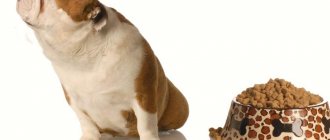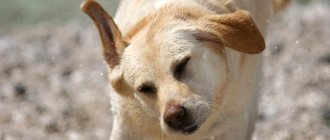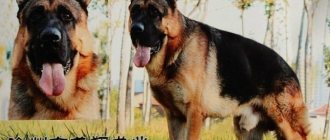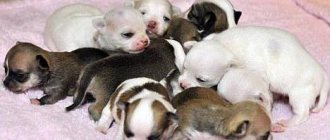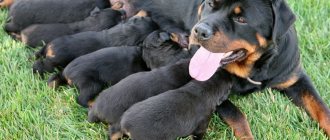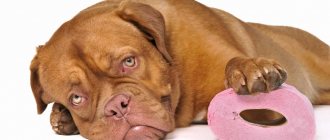First reason
It's no secret that a dog's sense of smell is thousands of times stronger and better than that of a human. Special glands that cover the dog's nose produce a thin layer of mucus that helps capture the slightest odors, and also acts as a kind of magnet to attract substance molecules - and this significantly improves sensitivity to odors and enhances the sense of smell.
Did you know? The distant ancestors of domestic pets, which are wild dogs and wolves, with the help of their strong sense of smell were able to quickly find prey, which allowed them to survive even in the harshest conditions.
[custom_ads_shortcode2]
Causes of a wet nose
According to veterinarians, the moisture in a dog's nose comes from a mixture of saliva and mucus. A dog's nose produces its own thin layer of mucus, and dogs add even more mucus and saliva by licking their nose frequently.
The details may be a little unsightly, but having a wet nose serves several vital functions for dogs. First, keeping their nose moist helps dogs regulate their body temperature. Dogs don't have sweat glands throughout their bodies like we do, so they rely on sweat glands in their nose and pads of their feet to help maintain a safe core temperature.
Moisture in the nose helps the dog evaporate heat and cool the body.
Dogs' wet noses also contribute to their incredible sense of smell. When dogs inhale, tiny scent particles floating in the air become trapped in the nasal mucus. This helps the dog distinguish and interpret odors.
Licking the nose helps dogs sniff even deeper. When a dog licks its nose, its tongue picks up some of the scent particles trapped in the nasal mucus. He then touches his tongue to an olfactory gland called Jacobson's organ, which gives the dog an even more detailed understanding of the chemical compounds that make up smells.
Their sense of smell is obviously much, much better than that of humans.
The second reason
The most obvious and simple explanation for why your pet has a wet nose is because he is constantly licking it frequently. In fact, this is done solely for hygienic purposes. Your pet understands perfectly well that after a walk or eating, his nose will definitely get dirty or clogged with dirt, which will significantly impair his sense of smell, and since the nose is the animal’s main tool for orientation in space, he licks it thoroughly and keeps it clean.
Moreover, dogs lick their nose to clear it of old mucus, which in any case has accumulated shades of “old” odors.
[custom_ads_shortcode3]
Third reason
Many owners know that dogs can regulate their body temperature by sticking out their tongues and breathing with their mouths open. This feature of the animal allows it not to sweat. However, every dog sweats quite a lot on its paw pads and, surprisingly, its nose.
This is the third reason why your pet’s nose is constantly wet. That is, a wet nose also serves as a heat exchange tool created by nature itself.
The nose helps the animal cool down when it is too hot, or, conversely, it becomes dry when the dog is cold . Thus, it becomes clear that a dog's health has nothing to do with a wet nose. Some scientists put forward the version that a dog’s thermoregulation is carried out through the nose, and not through the mouth, as was previously believed.
[custom_ads_shortcode1]
Speculation and theory
Scientists have been struggling with this seemingly very simple question for many years, but there is still no clear answer. But really, why do dogs have to have a wet nose? The main version of why a healthy animal has a cold and wet nose is that it is one of the main instruments of heat exchange besides the tongue, which dogs stick out when they are hot.
It would seem that this is a rather primitive way of thermoregulating the body, but it triggers a deep and imperceptible process - a change in the electrolyte and salt balance of the dog’s blood. This happens due to the fact that the body rapidly loses fluid and salts, thereby slowing down the metabolism. The breakdown of carbohydrates, which affects the dog’s body temperature, depends on the animal’s metabolic rate.
You also need to take into account the fact that the sweat glands in dogs are very poorly developed . They are located in only two places: on the nose and paw pads. Therefore, these glands take an active part in thermoregulation. When a dog breathes deeply and frequently, the liquid secretion of the sweat glands evaporates, which is why the dog cools down. A wet nose plays the same role.
This is interesting! Scientists also have an additional theory as to why healthy dogs should have a wet nose. The mucus secreted by special glands helps improve the sense of smell, as it attracts odors like a magnet.
If a dog experiences positive emotions, then its nose becomes even more moist, this is due to the fact that other glands associated with the emotional center are responsible for this.
In general, all versions are correct and valid, but which of them is the main one is a mystery.
Return to content
Fifth reason
Some breeds of pets have the wettest, coldest noses due to the characteristics of their respiratory system, as well as other properties that apply only to a certain breed of animal. For example, service dogs of search breeds have a nose that is especially abundant and highly moisturized.
This is explained by the fact that service breeds were formed according to the principle of selecting animals that have the most subtle and strong sense of smell. Representatives of other breeds, in which the sense of smell does not occupy a leading position in the list of advantages, have no less wet and cold noses, for example, dogs of decorative or fighting breeds.
[custom_ads_shortcode3]
Why a dog's nose "should be" wet and cold
A healthy dog's nose remains wet and cold only because he constantly licks it. Moisture on the nose helps enhance the sense of smell and makes it possible to determine which directions odors are coming from. A dry nose is considered normal after waking up from sleep, because while the dog is sleeping, it does not lick its nose.
If your dog's nose is dry and/or warm but looks normal, don't panic. You should contact your veterinarian if, in addition to a dry nose, other suspicious symptoms are observed. Contact your doctor immediately if:
- The nose becomes very cold and the mucous membranes turn blue.
- My nose is running.
- Cracks, scabs, or crusts appear on the nose.
- The nose is swollen, swollen, and changed shape.
Causes of a dry nose
Most often, a dry nose in a pet is a sign of a disease. Let's look at the main reasons for this phenomenon.
- Cold . A dry nose may be accompanied by other signs of illness, such as sneezing or coughing. Complete recovery is indicated by the normal moist state of the pet's nose.
- Allergy . Various factors and objects can act as irritants, ranging from the flowering of a plant to a plastic toy. To clarify. What exactly is an allergen, you should carefully monitor the behavior of your pet and gradually remove possible pathogens. You can also contact your veterinarian for tests to resolve the problem.
- Nose injury . Most often, dogs are very curious and constantly sniff out something, in the process they can get hurt and get infected. In this case, you yourself can identify the problem and solve it, but it is better to contact a specialist.
- Pemphigus is an autoimmune disease. Signs of this disease are the appearance of blisters not only in the nose area, but also in other parts of the animal’s body. After the blisters burst, a characteristic crust forms on the surface of the nose. This disease is tested and confirmed through histology.
- Dehydration. A dry nose is most often a consequence of dehydration in the animal. Remember to check your pet's bowl for clean water and change it regularly if it gets dirty or gets too hot.
- Weather factors. Extreme cold, heat or dry air can cause your pet's nose to dry out.
[custom_ads_shortcode1]
Why does my dog's nose become dry?
A dry nose reduces the sensitivity of smell, and this can lead to neurosis and even depression. Long-term nasal dryness leads to cracks and scabs that become greasy. After 3-4 days, the nose begins to bleed, and the dog becomes even more restless because it is in pain.
Causes of dry nose in dogs
- The condition of the nasal mucosa is influenced by external factors.
- The mucous membrane can dry out in direct sunlight and in hot weather.
- In the winter, when the heaters are on, the air in the apartment is dry, which can cause a dry nose.
- If you have an allergy, the skin on your nose can not only dry out, but also crack.
- Allergies can develop to food, plastic, household chemicals, flowering products, etc.
- Breed predisposition. Brachycephalics have problems with licking their muzzle due to the structural features of the skull. Miniature breeds often have problems with blocked tear ducts, which are connected to the sinuses and affect nasal hydration.
- Dehydration is the most common cause of dry nose and other mucous membranes. Dehydration can occur in hot weather, after strenuous exercise, or due to diarrhea, vomiting, or other painful conditions.
Dry nose can be explained by completely natural reasons - low activity, sleep.
If you notice that your dog has a dry nose, you can narrow down the possible causes by examining the gums:
- A rich pink color and the presence of saliva are normal.
- Dry and pale - a sign of dehydration.
- Dry and bluish - a sign of anemia, heart failure, respiratory problems, etc.
- Yellowish - problems with the liver, which can provoke dehydration, intoxication, and fever.
Removing allergens
The tricky thing about allergies is that the level of sensitivity to any suspected allergen will be different for each dog. Moreover, the level of sensitivity may vary depending on the season of the year, age and general condition of the dog.
The most common allergens that can cause nasal dryness are:
- Corn, wheat.
- Commercially produced chicken meat.
- Honey.
- Eggs.
- Plastic.
- Pollen.
- Dust.
Allergies are identified through specific tests or tracking. In the first case, there is a risk of obtaining false results, in the second, you will waste a lot of time.
Hydration
Some dogs have dry noses all the time or during certain seasons of the year. If you are sure that your pet is physically healthy, it is enough to moisturize the nose. Pet stores and veterinary pharmacies have a sufficient selection of balms and creams that retain moisture in the skin.
Video: why does a dog have a wet nose?
After watching this video, you will hear about interesting versions and reasons for your pet’s wet and cold nose.
Discussions about new causes of wet and cold noses in dogs continue among scientists to this day. However, the main thing is clear - this phenomenon is not a cause for concern. But if your pet has a dry nose, then under no circumstances ignore this factor and begin to solve this problem. If you know additional information regarding the topic discussed today, then share it in the comments.
It is generally accepted in society that a dog’s wet nose means that the pet is healthy, and a dry or warm nose means that the pet is sick. Everyone knows that dogs do not sweat their bodies, but cool themselves in other ways, and this has something to do with how wet a dog’s nose is. Let's take a closer look.
Oddly enough, scientists have repeatedly tried to understand this issue. We found out that dogs sweat through their nose and paws. This happens thanks to a cunning mechanism that four-legged animals control unconsciously.
When a dog breathes with its mouth open, all the mucous membranes on its face (mouth, nose, eyes) begin to work more actively. The mucus, blown by the dog's breath, quickly evaporates, cooling the shells.
This seemingly primitive method of cooling triggers a deeper and more invisible process - a change in the electrolyte and salt composition of the dog’s blood. Due to the fact that the body quickly loses fluid and salts, metabolism also slows down. It is the rate of metabolism of the animal that determines the rate of breakdown of carbohydrates, which heat the body.
In the process of research carried out by scientists, it was possible to find out that the evaporation of liquid from the nose cools the dog better than from the mouth, if we are not talking about severe overheating. Simply put, when a dog is uncomfortable, but not yet hot, his nose begins to actively moisten to lower his body temperature. When a dog is hot, it breathes with its mouth open.
This is interesting! With the exception of monkeys and a few other animals for which vision is more important, in all mammals on our planet the sense of smell is enhanced precisely by a wet nose.
Another important fact was discovered by American scientists (Pennsylvania State) while studying the sense organs of dogs. It's no secret that dogs' sense of smell is many times sharper than that of humans, but not many people know that this skill is explained by the mucus secreted by microscopic glands on the dog's nose. During the research, it turned out that due to the moist surface of the nose, odors are sorted.
This happens by the accumulation of odor-carrying molecules in certain areas of the nose. With evaporation, the smell spreads to very sensitive receptors. That is, a dog with a dry nose has a dull sense of smell, and he perceives the smell a split second later.
Note! A dry nose is not necessarily a sign of illness, but a sick dog loses its sense of smell is a proven fact.
The first and main reason is described above - a wet nose is a tool for cooling the body . The second reason is the secretion of mucus to enhance the sense of smell. By the way, it is in this case that the dog’s nose is hot and wet; this is normal, since an excited animal’s body temperature rises.
This is interesting! A dog's nose is a very complex mechanism that has been studied scientifically. The mucus that makes the nose wet is called lateral and vestibular, depending on which glands it is secreted from.
Another obvious reason is nose licking . A dog may lick its face if it is nervous ; this is a behavioral factor. To maintain a clean and sharp sense of smell, the four-legged dog regularly cleans its nose by licking. And the main reason is that the dog licks the mucus, which has already been “saturated” with odors, so that new mucus can be released.
Perhaps the dog is simply thirsty and is licking its nose for moisture. This is especially noticeable when the four-legged “rummage” in the morning grass, and then licks the dew from it. In hot weather, the dog deliberately pokes its nose into the grass and piles of leaves in order to wet its nose with moisture from the outside and cool down a little.
This is interesting! A dog's wet and cold nose is, in most cases, a matter of genetics, which is especially pronounced in search breeds.
After petting a pet and discovering that it has a dry, warm nose, the owner involuntarily begins to worry. This is the power of a belief, which, in fact, is not always true. The responsible owner takes the dog to the doctor, and the doctor declares that everything is fine.
The veterinarian receives the label of a “bad” specialist and the dog is sent to another clinic. In this case, the owner runs a greater risk of infecting the dog with something in the clinic itself than of finding a “hypothetical” disease.
Elementary, the dog could sleep in a warm place. During deep sleep, the pet does not see or hear anything, mucus on the nose is not produced, it dries out and becomes the same temperature as the body. The temperature and humidity of the nose change throughout the day and depending on the circumstances. On a walk, your nose is wet and cold, on the sofa it is dry and warm - this is also normal.
A puppy has a cold nose: is this always a good thing?
It is generally accepted that the coolness of the skin on a dog’s nose is a measure of their health. But even in this case, everything is not so simple. Yes, usually healthy puppies over three months of age do have a cool, moist nose. But even cool skin on the nose is not always a sign of a pet’s well-being:
- A cold nose is a “faithful companion” of severe dehydration (that is, it is typical for puppies).
- Of course, this same symptom is characteristic of all cases of hypothermia. However, if the puppy comes from a street walk in the cold season, you should not expect that his nose will be too warm.
- A decrease in overall body temperature is a characteristic sign of all septic processes. Unfortunately, in puppies this symptom is a common precursor to a near-death state.
- In addition, the nose (as well as the entire skin) becomes excessively cold during severe intoxication, since in this case the thermoregulation center in the brain practically does not work. This condition is extremely dangerous for puppies.
- Finally, the temperature of the nasal surface may change from hot to cold in the case of intermittent fevers (the so-called “temperature swing”).
Due to the imperfection of the thermoregulation system in puppies, most often a very cold nose is a consequence of the pet being hypothermic on the street. In this case, the baby should be placed in a warm (but not hot) room with good ventilation and given slightly warm water.
Normal condition
In a healthy state, the nose should be cool, because when the temperature rises, the mucous membrane quickly dries out and cannot produce secretions. There is an opinion that if a dog’s nose is hot, and not cold and wet, then the pet is not entirely healthy. However, such a condition does not necessarily indicate the presence of malaise.
Why under some circumstances the nose can be dry - you will learn about this further.
So, puppies have a dry nose both after active pastime and after sleep. Some time after waking up, the nose becomes wet. Sometimes a dog encounters something and the secretion production is disrupted, and as a result, the nose becomes dry.
After a while, secretion production resumes and the condition of the nose will become normal. If the animal is tired, the condition of the mucous membrane worsens. After rest, everything returns to normal.
Related article:
Why does a dog have bloody diarrhea and what to do? The mucous membrane also reacts to stress with dryness. Moving to a new place of residence, fright, saying goodbye to the owner - all this leads to a dry nose. After the dog calms down and gets used to the new conditions, everything will return to normal.
The nose may feel warm in an apartment where the heating is intense. To avoid this situation, the air in the room needs to be humidified. The simplest method is to place a bowl of water in the room or place a wet towel on the radiator.
[custom_ads_shortcode1]
When to worry
If the nose remains wet and cold, but the color of the mucous membrane has changed, then this circumstance should attract more attention than dryness.
The dog's nose is too cold - this symptom indicates a decrease in body temperature. The animal is frozen, has a cold or serious problems in the functioning of its internal organs. If, in addition to a cold nose, your dog has dull eyes, wheezing, cold ears, and pale gums, then this is a signal that the dog should visit a veterinarian.
A high temperature of the mucous membrane indicates that the animal has a fever. This could be a viral infection, injury, or an inflammatory process in one of the organs. If the pet is lethargic, constantly drinks, does not want to eat, is irritable, and is looking for a secluded place so that everyone will leave it alone, this is an alarming signal. The dog is sick and needs hospitalization. Try taking your temperature. Different breeds of dogs may have different normal parameters.
Before visiting a veterinary hospital, your pet's condition can be improved. Constant access to water must be provided. During viral infections, the animal must drink a lot.
In winter, you can apply a cotton swab dipped in water or saline solution to your nose. Treating your nose with fresh aloe juice will have a good effect.
On the eve of an examination by a veterinarian, you should not give your dog any medications, as the clinical picture of the disease will be blurred.
During allergic reactions, the nose may also be dry. One possible reason is a plastic feeding bowl. It is best to buy a stainless steel bowl for your pets. The reaction can also be caused by the flowering of indoor plants - in this case the plant should be taken out of the apartment.
[custom_ads_shortcode2]
When should you take your dog to the doctor?
Still, it’s worth talking about possible problems that a dog’s dry and hot nose can indicate.
In most cases, the mucus dries out due to an allergic reaction to something. It’s probably difficult to do without a veterinarian. He will be the one who will be able to identify the cause of the allergic reaction and tell you what measures need to be taken.
Perhaps your pet needs to change his bowl or bed, or limit some food or liquid. There have been cases where dogs have an allergic reaction to pollen during flowering. Just like people. In this case, during walks, you must avoid places where there are a large number of flowering plants.
A dry nose can also signal more serious problems. Drying mucus is usually caused by an illness such as bronchitis or pneumonia. At the same time, the nose becomes unusually cold. This is worth paying attention to, since in dogs such diseases are much more severe than in humans. Treatment is prescribed individually, depending on the breed, size and age of the dog.
If you suspect such a disease, you must immediately contact a specialist so that he can make an accurate diagnosis and prescribe the necessary treatment.
Our readers' pets
None to specialist.
Pets are unable to communicate when they feel unwell. But a caring owner can always notice this himself based on various signs. One of the main indicators of a dog’s well-being is the condition of the nasal mucosa.
The mucous membrane can be dry or moist, hot, warm or cool, clean, with ulcers or wounds. All violations indicate that the functions of this organ are not fully performed, and the reason may lie in both pathology and external conditions.
[custom_ads_shortcode3]
Nose in good condition
In dogs, unlike humans, the mucous membrane is located not only inside the nostrils, but also on the surface of the olfactory organ. It contains a large number of small glands that constantly secrete a mucous secretion. This lubricant performs an important function: it contributes to the perception and enhancement of all odors that surround the animal. As you know, for a dog, smell plays the role of the most important sense with which the pet navigates the surrounding world, so the loss of this ability is reflected in general behavior.
In order for the humidity to be maintained at the desired level, the nose should be moderately cool. When its temperature rises, the mucous membrane dries out faster than a new secretion can be produced.
[custom_ads_shortcode1]
Exceptions to the rules
Despite the fact that a moist and cool nose is considered normal, there are cases when temporary dryness does not indicate a possible serious illness. If dryness appears for the first time, it is important to pay attention to the following factors:
- After a long sleep, the earlobe is often warmer and drier than usual. It goes away within a few minutes of waking up.
- Allergy. The most common cause of allergic reactions in pet dogs is feeders made of plastic or other materials. The best option is a stainless steel bowl, which almost never causes allergies.
- On the hottest days, the air becomes too dry, which affects both the mucous membranes of dogs and people. The unpleasant sensation will quickly pass after treating the earlobe with water or a weak solution of calendula.
- Insufficient hydration sometimes appears due to injury. It does not necessarily manifest itself externally, but if a dog hits its nose, the functioning of the glands may be disrupted for a short time, after which it will recover on its own.
- After severe physical fatigue, the condition of the mucous membrane may worsen, but as soon as the animal rests, all indicators will return to normal.
- Moral worries and stress affect dogs no less than their owners. The cause of a dry nose is often fear, separation from someone in the household, or other dog troubles. When a puppy moves to a new home, this picture is considered typical. Everything will be restored as soon as the adaptation period ends and the pet gets used to its new place of residence.
In all of the above cases, in a healthy dog, the condition of the nose becomes normal within a short time after the irritating factor is eliminated.
[custom_ads_shortcode2]
What to do if your dog has a dry nose
The first step is to consider why your dog has a dry nose and whether it is a long-term problem. Olfactory receptors work best when the skin of the nose is moist and cool. Deterioration of odor is a significant threat to the animal. First of all, he may have trouble identifying threats in the environment.
You also need to know that only moisturized skin is flexible, but not susceptible to mechanical damage and other unpleasant ailments. A dry nose can become injured at the least expected moment. In addition, very often the skin peels, making it difficult for the four-legged to function on a daily basis.
Once the cause of your dog's dry nose is identified, appropriate measures can be taken. Perhaps all you need to do is make sure he drinks water regularly. Sometimes the animal refuses to drink because it considers the liquid in the bowl to be stale. There may be, for example, leftover food that the dog accidentally ate while eating. The influence of low and high temperatures should also be limited. You should also be careful when handling your dog near the air conditioner. It is also worth applying a moisturizing nose cream, which should be used systematically.
Cold nose
A too cold surface of the lobe may be a sign of a significant decrease in the animal’s body temperature. The rest of the body is covered with fur, so it is the nose that gives an idea of the coolness of the skin.
There are several reasons for this phenomenon:
- hypothermia;
- colds or viruses;
- serious malfunctions in the functioning of internal organs.
In this case, the main signals indicating that the dog urgently needs to be shown to a specialist are:
- dull or watery eyes;
- bloodless gums;
- cold surface of the ears;
- wheezing.
[custom_ads_shortcode3]
If your nose is dry
It is believed that if a dog's nose is deprived of moisture, it means he is sick. But does earlobe dryness always indicate health problems? What are the true reasons for a dog's warm nose?
If you notice a dry nose on a dog, this does not always mean that it is sick.
- If the animal has just woken up, its lobe may be dry and warm. Rejoice - there is no reason to worry.
- The second reason is allergies. It is believed that the animal may have allergic reactions to dishes made from inappropriate materials (for example, plastic). Usually the problem is solved by replacing the plate with a better one and the dog again acquires its usual wet nose.
- Is it too hot outside? This is the reason for a dry nose. Your pet can also feel these unpleasant moments, which is why his nose will become warm. In this case, there is no reason to worry - the lobe can simply be moistened with a calendula solution or plain water.
- Trauma is another reason why you may have a dry earlobe. In this case, it also becomes bubbly. That’s why you can’t click your pet’s nose – this area is too sensitive in a dog.
- Stress and overwork are the reasons why a pet may have a warm nose. This means that the pet just needs to take a breath and calm down, and then the lobe will restore its normal temperature. This is especially true for a puppy who finds himself in an unfamiliar environment.
Hot and dry
Too high a temperature in the nasal mucosa is almost always combined with dryness. This symptom always indicates a disease that causes fever. The reasons for this include infectious pathology or significant trauma, as well as an inflammatory process. First of all, it is important to make sure that the dog is not experiencing heatstroke.
Immediate contact with a veterinarian is necessary in cases where a hot and dry nose is combined with the following symptoms:
- weakness, lethargy and sleeping longer than usual;
- constant desire to drink;
- loss of appetite;
- increased irritability and aggression;
- the dog tries to hide in a secluded place where no one will disturb him;
- obvious intestinal disorders (diarrhea, vomiting);
- swelling of the nose;
- blisters and peeling on the mucous membrane;
- frequent sneezing and paroxysmal cough, runny nose;
- hoarse voice.
It's good if the dog can measure the temperature. The values for this parameter differ for dogs of different ages and sizes, and also change in pregnant or lactating bitches.
[custom_ads_shortcode1]
